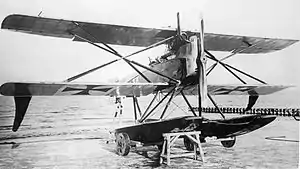Hansa-Brandenburg W.11
The Hansa-Brandenburg W.11 was a fighter floatplane built in Germany in 1917 as a more powerful version of the KDW. Similar in general configuration to its predecessor, the W.11 shared the same unusual interplane strut arrangement, and featured fins above and below the fuselage. Only three examples were built.
| W.11 | |
|---|---|
 | |
| Role | Fighter seaplane |
| National origin | Germany |
| Manufacturer | Hansa-Brandenburg |
| First flight | 1917 |
| Status | prototypes only |
| Number built | 3 |
Specifications
General characteristics
- Crew: One pilot
- Length: 8.10 m (26 ft 7 in)
- Wingspan: 10.10 m (33 ft 2 in)
- Height: 3.32 m (10 ft 11 in)
- Wing area: 31.4 m2 (338 sq ft)
- Empty weight: 935 kg (2,060 lb)
- Gross weight: 1,233 kg (2,718 lb)
- Powerplant: 1 × Benz Bz.IVa , 160 kW (220 hp)
Performance
- Maximum speed: 176 km/h (110 mph, 96 kn)
- Range: 350 km (217 mi, 189 nmi)
Armament
- 2 × fixed, forward-firing 7.92 mm (.312 in) MG 08 machine guns
References
| Wikimedia Commons has media related to Hansa-Brandenburg W.11. |
- Taylor, Michael J. H. (1989). Jane's Encyclopedia of Aviation. London: Studio Editions. p. 472.
- World Aircraft Information Files. London: Bright Star Publishing. pp. File 896 Sheet 12.
This article is issued from Wikipedia. The text is licensed under Creative Commons - Attribution - Sharealike. Additional terms may apply for the media files.